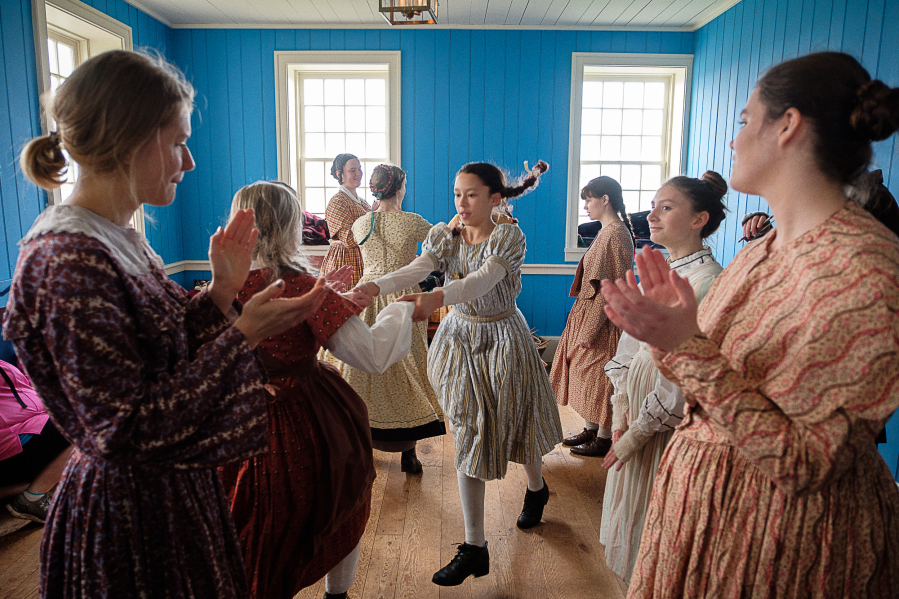At Fort Vancouver in the 1840s, you had to make everything by hand.
If you wanted music, you learned to fiddle. If you wanted merriment, you learned to dance and sing. If you wanted to play, you fashioned toys out of wood. If you wanted bread, you baked it.
And if you wanted fire — to keep warm, to bake that bread, to shoot a gun — you struck it with steel and flint. Once that was done, you preserved it for as long as you possibly could, according to ranger Mike Twist. Because, as Saturday’s weather made plain, generating sparks and nurturing an actual flame at this cold, wet time of year takes a lot of labor.
But in the end — after many minutes of striking and puffing, striking and puffing — a little flame grew in a piece of fabric and got touched to the weapon, whose proper name is not a flintlock but a “firelock,” Twist said — and BANG! The 2 p.m. black powder demonstration, initially canceled because of rain, happened at last.
Nothing could be more authentic about an 1840s Christmas at the fort — or a 2016 Christmas anywhere in the Pacific Northwest — than a teeming downpour that gives way to a rainbow. But Saturday’s shower didn’t seem to chase anybody away from Christmas at Fort Vancouver, the annual celebration and demonstration of making your own.
“It’s nice. It’s real life,” said 10-year-old Karinna Yakimchuk, who attended Christmas at Fort Vancouver with her aunt Liliya Yefimov. When The Columbian bumped into them they were standing under the eaves of the central Chief Factor’s House, waiting for the rain to stop, and Yefimov was reassuring her niece that her handmade wreath would dry out again.
But Yakimchuk seemed unconcerned about that. “Making stuff is really fun,” she said. “Simple toys are better than expensive toys.”
She learned that lesson at the very popular carpentry shop, where people were sawing, sanding, sharpening and hammering toy tops together. Rowan Welchel, 7, was just as excited. “I like doing things like this. We do crafts at home,” he said. (His mother, La Center Middle School teacher Shae, added that the previous day’s home project had been melting down bits of used crayons to make new, multicolored ones.)
OK, not all was entirely authentic to the 1840s. The sawing was courtesy of a shiny new tool embedded between wood blocks for safety; the tops’ wooden dowels were sharpened in pencil sharpeners.
The music and dancing in the Counting House were the real thing, however. Battle Ground violinist Ben Coder performed really authentic yuletide melodies — like “I Saw Three Ships (On Christmas Day in the Morning”), which dates from the 1600s — while a small group of costumed, dancing volunteer girls laughingly rehearsed jigs and reels. No volunteer boys summoned the nerve to dance with them; that seemed pretty authentic, too.
“Just imagine having to stand here on guard duty,” said Lynel Bortles from a dark, chilly spot inside the fort’s northwest guard tower. Bortles and his wife, Linda, were visiting from Lake Stevens for the Kennel Club Dog Show at the Clark County Events Center, but they were also glad to visit the historic fort they’d heard so much about, they said.
“You read a lot about history but this is a different experience,” Lynel Bortles said. “I like this.”
Treeless in the forest
In addition to special seasonal happenings like wreath- and toy-making, the fort’s regular 1840s re-enactors were running the bakery, the kitchen, the blacksmith shop, the fur warehouse. There was so much to see and do at the fort on Saturday, it was easy to miss that a major piece of modern Christmas was not part of the 1840s scene: a tree.
“This was before the era when Christmas trees became a popular item,” said ranger Bobby Gutierrez. “That tradition really starts with the British royal family and the British populace, about a decade afterwards.”
Gutierrez pointed out that officers of the Hudson’s Bay Company and the residents of the surrounding worker village would have been used to “a stringent work policy of six days a week, 12 hours a day,” he said. Holidays were rare and there was no such thing as a vacation.
The only exception was one whole week at Christmastime, he said — a precious pause for relaxation and celebration.




